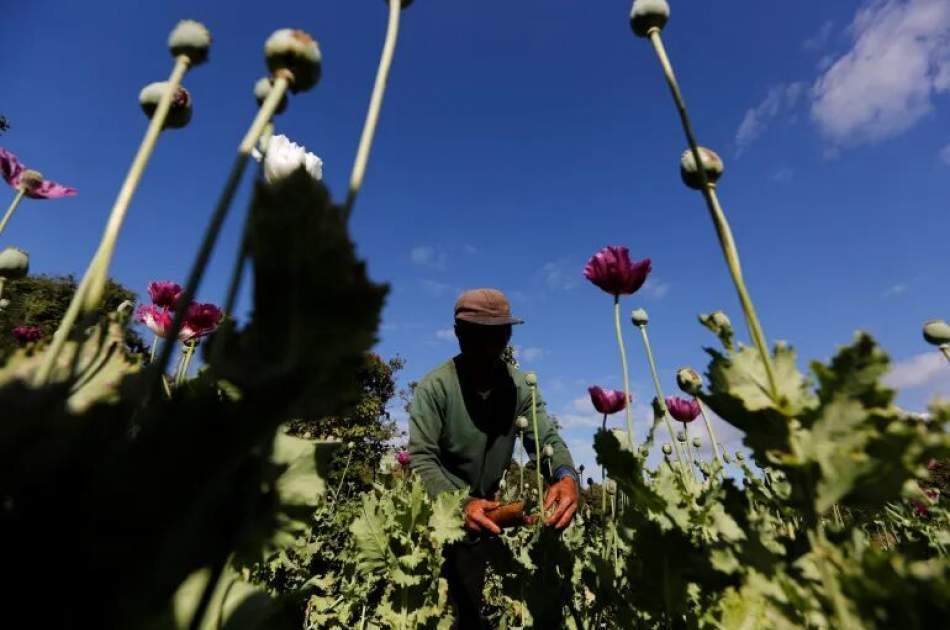The United Nations announced in its new report that Afghanistan is no longer the largest producer of narcotics in the world, and Myanmar has become the largest producer of opium in the world by surpassing Afghanistan in 2023.
Publish dateWednesday 13 December 2023 - 10:27
Story Code : 282098
Afghan Voice Agency (AVA): The United Nations Office on Drugs and Crime wrote in a report: 95% decrease in opium cultivation in Afghanistan after the prohibition of drugs by the caretaker government in 2022, the main reason for the transfer of the global supply of opium. The drug has been to Myanmar, where the political, social and economic instability caused by the 2021 coup led many to grow the poppy.
According to the report, Myanmar farmers are now earning about 75% more from poppy cultivation than before, as the average price of the drug has reached $355 per kilogram.
From 2022 to 2023, Myanmar increased the estimated amount of land used for illegal crop cultivation by 18 percent, from 40,100 to 47,000 hectares (99,000 to 116,000 acres).
It is stated in this report: Although the cultivated area has not returned to the maximum cultivated land in history, which is nearly 58 thousand hectares (143 thousand acres) that was cultivated in 2013, but after three consecutive years of increase, poppy cultivation in Myanmar is expanding further.
This report added: The opium cultivation areas in the border regions of Myanmar in the north of Shan state, followed by China and Kachin states, have increased the most because due to more advanced agricultural methods, production has increased by 16 percent. It has increased to 22.9 kg per hectare.
Violent political turmoil in Myanmar has helped fuel opium production.
Jeremy Douglas, regional representative of the United Nations Office on Drugs and Crime, said: "The economic, security and governance turmoil that followed the military takeover in February 2021 continues to push farmers in remote areas to turn to opium to make ends meet." make a living
Armed conflicts in Shan State, a traditional but growing region, and other border regions are expected to accelerate this process, he said.
The report noted that poppy cultivation in Southeast Asia is closely related to poverty, lack of government services, unstable macroeconomic environments, social unrest, and insecurity.
According to IRNA and according to Al Jazeera, the northeast of Myanmar is part of the infamous region known as the "Golden Triangle", where the borders of Myanmar, Laos and Thailand meet. Heroin has historically thrived.
In recent decades, with the decrease in opium production in the region, it has been replaced by methamphetamine in the form of pills and crystal meth.
In a statement accompanying its report, the United Nations Office on Drugs and Crime said that growing drug production in the region is contributing to a growing illicit economy that is fueled by high levels of synthetic drug production and the convergence of drug trafficking. It combines narcotics, money laundering and online criminal activities and fraud operations.
Afghanistan was the largest producer of opium in the world in the past few years. However, after the establishment of the Islamic Emirate government, its planting and production has decreased drastically.
According to the report, Myanmar farmers are now earning about 75% more from poppy cultivation than before, as the average price of the drug has reached $355 per kilogram.
From 2022 to 2023, Myanmar increased the estimated amount of land used for illegal crop cultivation by 18 percent, from 40,100 to 47,000 hectares (99,000 to 116,000 acres).
It is stated in this report: Although the cultivated area has not returned to the maximum cultivated land in history, which is nearly 58 thousand hectares (143 thousand acres) that was cultivated in 2013, but after three consecutive years of increase, poppy cultivation in Myanmar is expanding further.
This report added: The opium cultivation areas in the border regions of Myanmar in the north of Shan state, followed by China and Kachin states, have increased the most because due to more advanced agricultural methods, production has increased by 16 percent. It has increased to 22.9 kg per hectare.
Violent political turmoil in Myanmar has helped fuel opium production.
Jeremy Douglas, regional representative of the United Nations Office on Drugs and Crime, said: "The economic, security and governance turmoil that followed the military takeover in February 2021 continues to push farmers in remote areas to turn to opium to make ends meet." make a living
Armed conflicts in Shan State, a traditional but growing region, and other border regions are expected to accelerate this process, he said.
The report noted that poppy cultivation in Southeast Asia is closely related to poverty, lack of government services, unstable macroeconomic environments, social unrest, and insecurity.
According to IRNA and according to Al Jazeera, the northeast of Myanmar is part of the infamous region known as the "Golden Triangle", where the borders of Myanmar, Laos and Thailand meet. Heroin has historically thrived.
In recent decades, with the decrease in opium production in the region, it has been replaced by methamphetamine in the form of pills and crystal meth.
In a statement accompanying its report, the United Nations Office on Drugs and Crime said that growing drug production in the region is contributing to a growing illicit economy that is fueled by high levels of synthetic drug production and the convergence of drug trafficking. It combines narcotics, money laundering and online criminal activities and fraud operations.
Afghanistan was the largest producer of opium in the world in the past few years. However, after the establishment of the Islamic Emirate government, its planting and production has decreased drastically.
avapress.com/vdci3rarvt1avu2.ilct.html
Tags
Top hits







